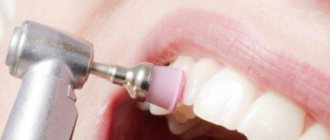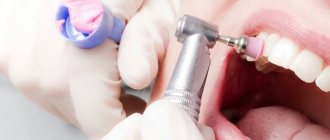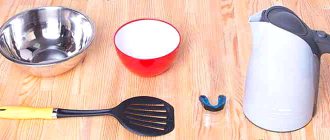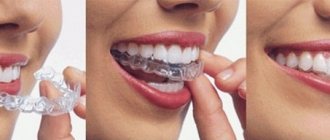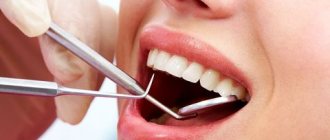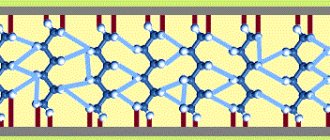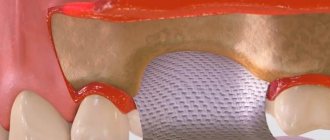Dental hygiene is a necessary measure that allows you to maintain the health and strength of your teeth for a long time. There are many ways to clean teeth in dentistry. One of the most common is polishing teeth with paste. The principle of operation is the complex action of cleaning mechanisms and abrasive pastes. Teeth polishing is done with special tools with rotating heads. As they rotate, they smooth and clean the surface of the tooth. Thus, brushes are preferable on the bumps, as they can damage the gums and soft tissues, and rubber attachments are preferable on the flat surfaces of the tooth, because other places are inaccessible to them.
Just like the type of instrument for the procedure, the doctor selects the paste individually, based on the characteristics of the dental system of a particular patient. Pastes vary in their degree of granularity. Typically, several drugs are used per session, gradually reducing the degree of granularity. Thanks to this, you can achieve the best effect, straighten and make your teeth smooth. After all, the less rough they are, the more difficult it is for plaque to appear on them again. Their composition can be different, but fluorite is often used to strengthen the enamel.
You can polish not only healthy teeth, but also fillings and crowns, which helps get rid of some plaque on them, strengthens their strength and restores color.
Why do you need to polish your teeth?
Despite the fact that grinding and polishing are included in the complex of measures for removing stone, they can also be used as independent procedures aimed at improving the general condition of the enamel. Grinding is performed in order to remove unevenness and microcracks from the enamel surface. Thus, grinding the enamel helps reduce plaque and slows down the formation of stones. In addition, grinding helps improve the general condition of the enamel and is one of the preventive measures for the development of caries. Polishing is carried out after grinding. It is intended for the final leveling of micro-irregularities on the enamel that could remain after grinding. In general, polishing is more cosmetic in nature and provides a slight whitening effect.
Reviews about our dental therapists
I would like to express my gratitude to the dentist Elena Nikolaevna Kiseleva and her assistant Svetlana - they are real specialists and at the same time sensitive, not burnt out by years of practice.
Thanks to them, I have been coming back here for many years. Thanks to the management for such doctors! Read full review Svetlana Nikolaevna
13.08.2021
Words cannot express my gratitude to Elena Nikolaevna Kiseleva. This is the best doctor in the world. I got an appointment after many years of being ignored by the dentist’s office and with a bitter experience of treatment in another paid clinic, the mistakes of which had to be corrected in the first visits. Thank you for this... Read full review
Roman Stanislavovich Sh
25.07.2020
Polishing pastes
During the procedure, special polishing pastes are used; it is desirable that they contain fluoride preparations for the remineralization of treated dental tissues and weak antiseptic agents. The composition of these pastes is close to the composition of pastes for individual oral care, however, they are more abrasive. The following is used as an abrasive filler:
- pumice,
- silicate or aluminum oxide,
- silica,
- zircon.
Polishing pastes should be available in a full range of grain sizes. They are produced in large tubes or “unidoses” (single doses). To work, it is convenient to place the polishing paste in the ring-shaped holder.
Polishing begins with a coarse polishing paste with a rubber cup, then treatment is carried out with a medium-grained paste, thanks to which the unevenness formed by the previous paste is smoothed out. Only if you follow the order of alternating polishing pastes can you obtain a smoothly polished surface.
Finally, final polishing is carried out with a fine-grained fluorine-containing paste. In addition to the gradation of pastes by grain size, an important indicator is the RDA indicator - radioactively measured dentin abrasiveness. The lower the RDA number, the lower the abrasiveness. The higher this number, the higher the abrasiveness.
Contraindications to teeth polishing
The benefits of polishing for the health and aesthetics of a smile cannot be overestimated. However, at present there are several contraindications to its implementation:
- gum disease;
- caries;
- increased sensitivity of enamel;
- the occurrence of any inflammation in the oral cavity;
- individual intolerance to at least one of the components of the drug;
- adherence to a salt-free diet for renal failure;
- the presence of certain chronic diseases.
Therefore, before undergoing the procedure, it is necessary to consult a dentist.
Tools for the procedure
Polishing requires special dental instruments. The drill starts at a speed of 2000-5000 rpm, which is safe for the enamel structure. And various attachments are used as the main tool:
- rubber in the shape of cups - help to level all flat surfaces;
- cone-shaped brushes - treat lumpy chewing sides;
- strips (polishing strips) – coated with diamond or aluminum coating for maximum cleaning of interdental spaces.
Teeth grinding tools
For polishing, special tools with rotating heads are used, which are fixed to the contra-angle tip of the drill. The principle of operation is the complex use of cleaning mechanisms and abrasive pastes.
The following are used as nozzles:
- rubber cups – suitable for treating flat tooth surfaces;
- cone-shaped brushes – designed for lumpy areas;
- polishing strips (strips) coated with aluminum oxide or diamond coating - for cleaning proximal surfaces, that is, the area of contact between the teeth.
During the polishing process, the dentist alternately uses several types of abrasive pastes, ranging from coarse to medium- or fine-grained.
The degree of abrasiveness of the paste is indicated by the RDA index:
- 250 (blue) – coarse-grained mixture for removing dense deposits;
- 170 (green) – medium-grained;
- 120 (red) – fine paste;
- 40 (yellow) – extra soft for final polishing.
The main component (abrasive) of polishing pastes is silica, ground zircon, silicate or zirconium oxide. The preventive effect is provided by such useful components as ionized fluorine and xylitol.
Abrasive tooth polishing paste
Stages of the procedure
Before the procedure, the dentist examines the oral cavity and removes the stone. Next, depending on the condition of the teeth and gums, as well as the presence or absence of contraindications, the doctor chooses one of the methods of performing the procedure and selects the necessary tools and materials. The entire procedure takes about half an hour and does not require anesthesia.
First, the flat lateral surfaces are processed, then the chewing surfaces, and at the end of the procedure, the interdental space is polished. As mentioned above, grinding and polishing is an absolutely painless procedure that does not cause discomfort to patients. However, patients with sensitivity or periodontal disease may experience discomfort during grinding. Grinding and polishing enamel not only does not have a harmful effect on the enamel, but also helps strengthen it, reduces the rate of formation of plaque and stones, and is also one of the methods for preventing caries and inflammatory gum diseases. In addition, polishing removes darkening of the enamel, which significantly improves the color of teeth.
Usually polishing is carried out with an abrasive paste. In this case, special tools with rotating cone-shaped heads are used. There are two types of tools for treating teeth with paste:
- Brushes are coarser, so they are used for grinding that part of the tooth that does not come into contact with the gum;
- Rubber cups have a gentler effect on the enamel, without irritating or injuring the gums.
The abrasive substances used to clean darkened enamel can also be different. They differ in such parameters as:
- Compound;
- Grain level.
POLISHING PASTES
Polishing pastes in dentistry are used for enamel and for filling materials.
Polishing is what ends any procedure for installing a dental filling, because plaque adheres to smooth, polished teeth much less actively than to rough surfaces. In this case, the dentist polishes not only the filling itself, but also grinds its edges to give uniformity to the boundaries of the tooth and filling. In the case where the edges of the filling hang over the tooth, there is a possibility of food debris getting into the voids and, as you understand, this will not lead to anything good. Polishing of fillings is also done to eliminate possible discomfort, because roughness will be more noticeable for the oral mucosa, which is sensitive to any foreign bodies.
Polishing teeth with pastes is an integral part of professional teeth cleaning. They contain abrasives that effectively remove dense plaque, and during the polishing process large particles break up into small ones. This is harmless to the enamel.
Polishing pastes for fillings
CleanPolish – Kerr – CleanPolish 50g (360)
Paste for pre-polishing fillings made of gold, amalgam and composites, as well as for cleaning and polishing teeth
SuperPolish – Kerr – SuperPolish 45gr (361)
Paste for obtaining a mirror shine. Gives gold fillings, composite and amalgam fillings an extraordinary shine.
PolishPast D - Preliminary - Omega-Dent
Indications. Polishing paste for preliminary grinding and polishing of the surface of fillings made of light- and chemical-curing composite materials. Ingredients: diamond abrasive, water-soluble polymer base, silicone additives, stabilizer, fragrance Properties. The operating principle of “PolishPaste – D – Preliminary” is based on the specific abrasive properties of fine diamond powder. Thanks to these properties, diamond abrasive grinds and pre-polishes the formed filling made of composite materials
PolishPaste D - Dry shine - Omega-Dent
Indications. Polishing paste for final polishing of the surface of fillings made of light- and chemical-curing composite materials to a dry shine. Ingredients: diamond abrasive, water-soluble polymer base, silicone additives, stabilizer, fragrance Properties. The operating principle of "PolishPaste - D - Dry Shine" is based on the specific abrasive properties of fine diamond powder. Thanks to these properties, diamond abrasive produces final polishing of the formed composite filling to a dry shine.
PolishPast D – Finish – Omega-Dent
Indications. Polishing paste for final polishing of the surface of fillings made of light- and chemical-curing composite materials. Ingredients: diamond abrasive, water-soluble polymer base, silicone additives, stabilizer, fragrance Properties. The operating principle of "PolishPast - D - Finish" is based on the specific abrasive properties of fine diamond powder. Thanks to these properties, diamond abrasive produces the final polishing of the formed filling made of composite materials.
Polyrene No. 3 - paste for final processing of fillings made of composite and glass ionomer materials
INDICATIONS FOR USE
— filling fillings made of composite and glass ionomer materials
ADVANTAGES
— high-quality processing of fillings — ease of use — convenient application — excellent washability with water — “dry” shine effect
RELEASE FORM
can - 45g
Teeth polishing paste
Detartrine - Septodont - Detartrine
Paste for removing tartar Cleansing paste for scaling Composition (per 100 g): Silicone 55 g. Filler up to 100 g.
Properties: Detartrine is a paste with a pleasant taste, has excellent cleaning properties, allowing for high-quality polishing of the tooth surface after scaling, as well as removing soft plaque. The oils present in Detartrine provide excellent taste and patient comfort.
Indications: Final treatment of the tooth after scaling. Removal of smoker's pigmented plaque Final polishing of fillings.
Contraindications: Allergic reaction to paraformaldehyde.
Directions for use: Take the required amount of paste with a spatula, apply it to a circular brush, and polish the surface.
Attention! Rinse off the paste thoroughly after polishing.
Release form: Packaging 45 g
Detartrine Z - Septodont - Detartrine
Composition Silicon dioxide………………………………………43.44 g Ground zirconium silicate……………………….13.50 g 35% formaldehyde solution…………… ………………….0.10 g Filler in sufficient quantity for………..100 g
Properties DETARTHRIN Z is a pink paste with a very pleasant smell. DETARTHRIN Z has an abrasive effect specific to dentistry, thanks to the zircon granules included in the preparation. Under a microscope, these granules are visible in the form of flat scrapers, which are separated from each other, forming a cutting edge of great strength. When this powder is rubbed over a rough surface, the cutting edge of the granules eliminates the roughness. It is this property of crushed zirconium that helps DETARTHRIN Z paste remove dental plaque without damaging the enamel. The essential oils contained in the paste give a feeling of freshness, which is greatly appreciated by patients. In addition, essential oils have a slight embalming effect. Therefore, gum irritation that may occur as a result of mechanical removal of dental plaque is minimal.
Indications • Finishing treatment after removal of dental plaque. • Removing tobacco and food stains. • Polishing of fillings.
Method of use: Take the required amount of paste on a spatula and lubricate the circular brush with it.
Warnings Risk of allergy to formaldehyde.
PolishPast Z – Omega-Dent – zirconium
Indications: - removal of tartar by mechanical means; — final polishing of fillings made of chemical and light-curing composite materials. Ingredients: fine abrasive, binding components, filler, fragrance, silicone additives Properties. The operating principle of "PolishPast - Z" is based on the specific abrasive properties of fine abrasive. Thanks to these properties, “PolishPaste - Z” removes tartar without damaging the enamel. In addition, during the final polishing of fillings, fine abrasive gives them shine.
PolishPaste Z+F – Omega-Dent – zirconium + fluorine
Indications. Removing soft plaque mechanically; final polishing of enamel after removing tartar; fluoridation of tooth enamel; antiseptic treatment of enamel. Ingredients: fine abrasive, binders, fluorine-containing components, filler, flavor, silicone additives. Properties. The operating principle of "PolishPast - Z+F" is based on the specific abrasive properties of fine abrasive with the addition of fluoridating components. Thanks to these properties, “PolishPaste - Z+F” removes soft plaque without damaging the enamel. In addition, during the final polishing of the enamel after removing tartar, especially on teeth affected by periodontal disease, it is very important, by polishing the surface, to eliminate all kinds of irregularities and cracks, which prevents new formations of tartar.
PolishPaste Z+W – Omega-Dent – zirconium + carbamide peroxide
Indications: final polishing and whitening of enamel after removing tartar; removal of soft dental plaque mechanically; fluoridation of tooth enamel. Ingredients: fine abrasive, binders, titanium dioxide, carbamide peroxide, filler, flavor. Properties. The operating principle of "PolishPaste - Z+W" is based on the specific abrasive properties of fine abrasive and the bleaching properties of carbamide peroxide. The combination of aminofluoride with potassium nitrate helps saturate the enamel with fluoride ions and relieve enamel sensitivity. Thanks to these properties, “PolishPaste - Z+W” removes soft plaque without damaging the enamel and produces whitening, which is very important when imparting high aesthetic properties.
Polyrene No. 2 - paste for treating enamel before restoration
INDICATIONS FOR USE
treatment of enamel before restoration or teeth whitening, before sealing fissures to remove soft plaque for the prevention of caries
ADVANTAGES
Effective cleaning of enamel High-quality removal of soft plaque and pellicles in hard-to-reach places and fissures Reliable prevention of caries (professional cleaning) Convenient spot application Easy to use Easily washed off with a water-air jet Pleasant refreshing taste
RELEASE FORM
jar 45 g
Polyrene No. 1 - paste for softening and removing tartar without damaging the enamel
INDICATIONS FOR USE
— softening and removal of tartar without damaging the enamel.
ADVANTAGES
— quick softening and removal of tartar — convenient spot application — easily washed off with a water-air jet — pleasant refreshing taste
RELEASE FORM
jar 45 g
Recommendations after the procedure
After any activities related to professional teeth cleaning, including after polishing, the patient is recommended to avoid eating foods such as coffee, tea, chocolate, and beets for several days. This is due to the fact that there is a high probability that a polished tooth will acquire the shade of these products. Smoking is also not recommended - ideally you should quit smoking.
Teeth polishing should be carried out no more than once every six months in order to avoid excessive wear of tooth enamel. After this procedure, the doctor should recommend which toothpaste the patient can use. The use of highly abrasive bleaching pastes should be avoided. It is better to use fluoridating pastes.
Chemicals for removing dental plaque
Chemical plaque removers have been widely used since the beginning of the last century.
They used sulfuric acid, and later hydrochloric, nitric, trichloroacetic, lactic acid, ammonium fluoride, and fluoroglucinic sulfuric acid. Due to the possible harmful effects on hard dental tissues, the acid method of dissolving mineralized dental plaque is not widely used. However, even now, a number of chemicals, mainly acids, are used to soften tightly fixed mineralized dental deposits before their final removal, especially on mobile teeth. Iodine is often added to such compositions to simultaneously stain tartar and provide an antiseptic effect. Depuration Solution (Products Dentaires, Switzerland) contains hydrochloric acid (20%), iodine (0.5%), chloroform (20%). Detartrol ultra (Septodont) includes concentrated hydrochloric acid (20%), iodine (0.75%), chloroform (20%). The softening gel produced by VladMiV (Russia) is made on the basis of natural polysaccharide and also contains acids. To soften dental plaque, compositions were also proposed that included 3H hydrochloric acid (1.7), a saturated solution of hydroquinone (10), ascorbic acid (0.1) (D. G. Myaskovsky, 1978), trichloroacetic acid and 50% lactic acid.
The preparations are applied to the surface of mineralized dental plaque for 30-60 seconds. (sometimes for a longer time), after which they are washed off, and the tartar is removed using conventional methods.
